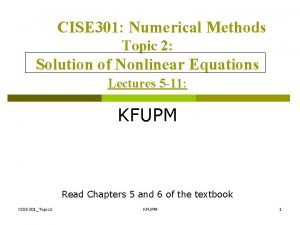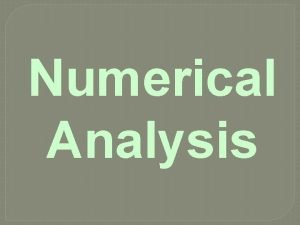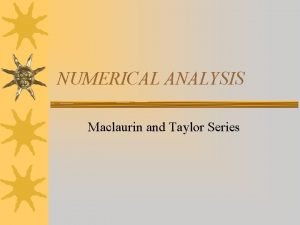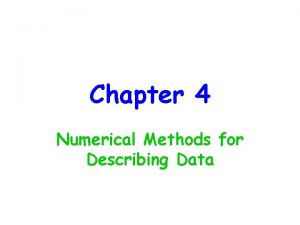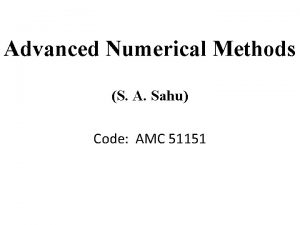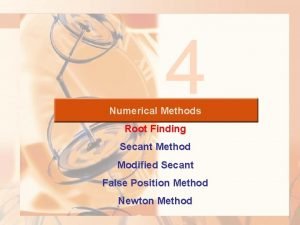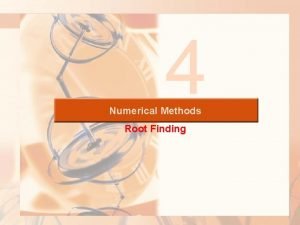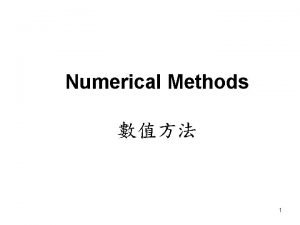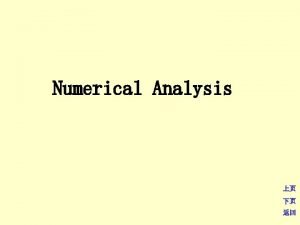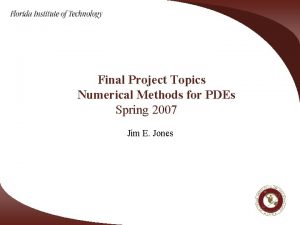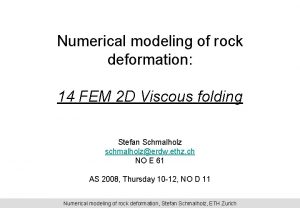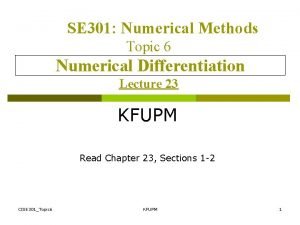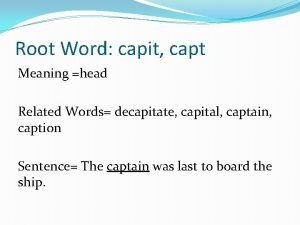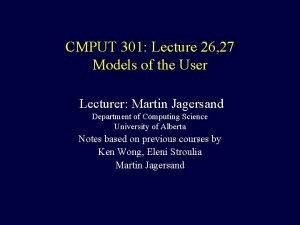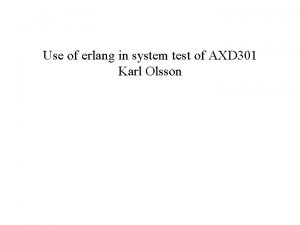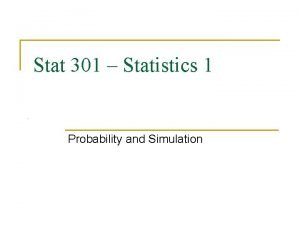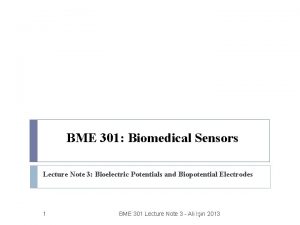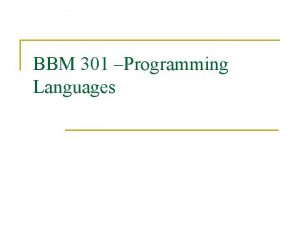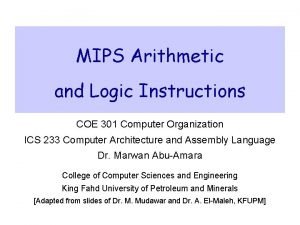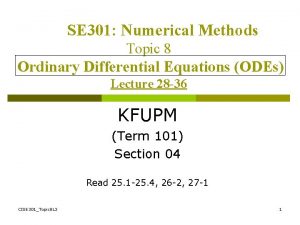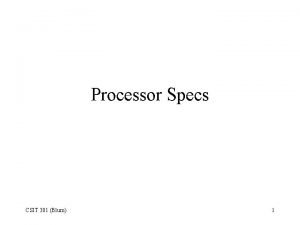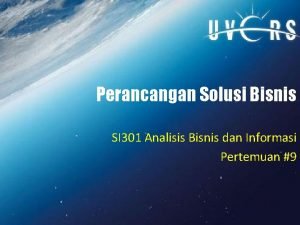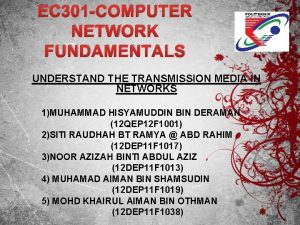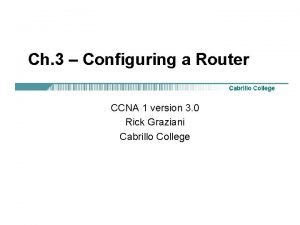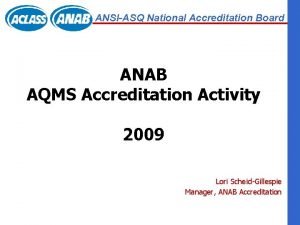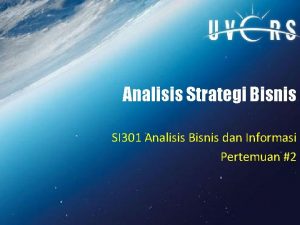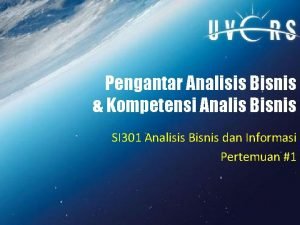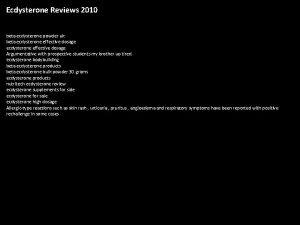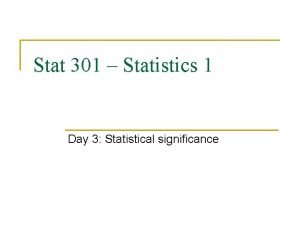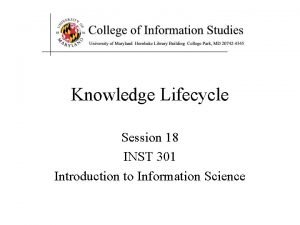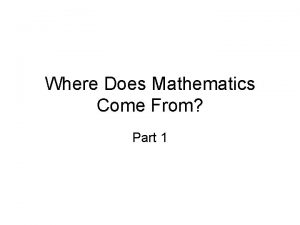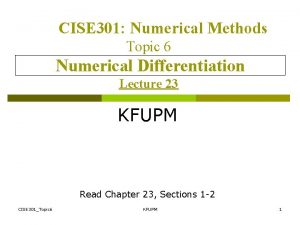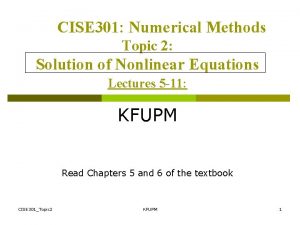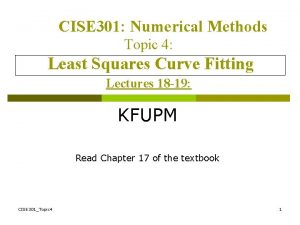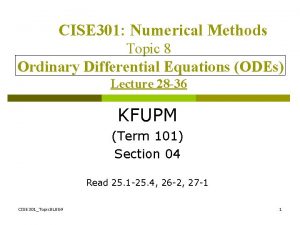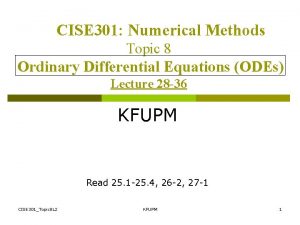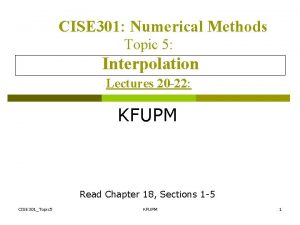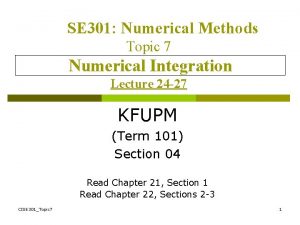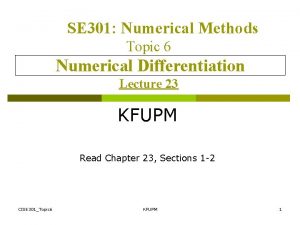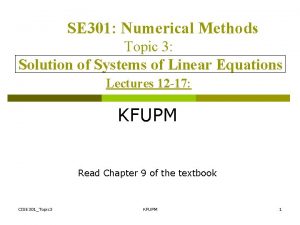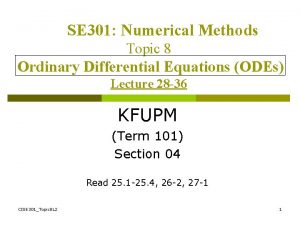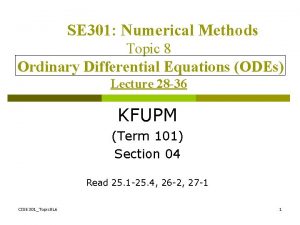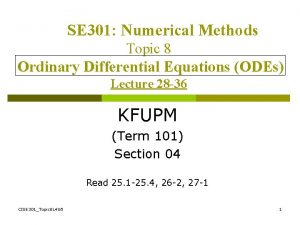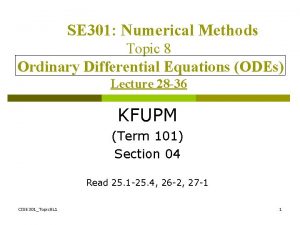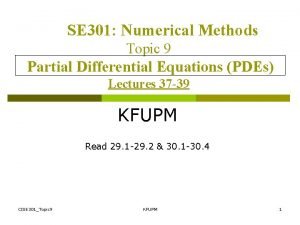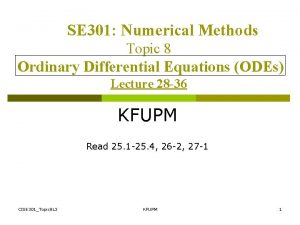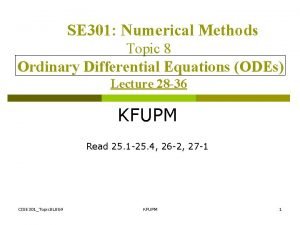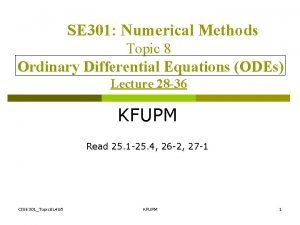CISE 301 Numerical Methods Topic 2 Solution of






















![Intermediate Value Theorem p p Let f(x) be defined on the interval [a, b]. Intermediate Value Theorem p p Let f(x) be defined on the interval [a, b].](https://slidetodoc.com/presentation_image_h2/14209ac2d95501a3405d89ae60fd202a/image-23.jpg)


![Bisection Method p If the function is continuous on [a, b] and f(a) and Bisection Method p If the function is continuous on [a, b] and f(a) and](https://slidetodoc.com/presentation_image_h2/14209ac2d95501a3405d89ae60fd202a/image-26.jpg)
![Bisection Method Assumptions: Given an interval [a, b] f(x) is continuous on [a, b] Bisection Method Assumptions: Given an interval [a, b] f(x) is continuous on [a, b]](https://slidetodoc.com/presentation_image_h2/14209ac2d95501a3405d89ae60fd202a/image-27.jpg)
![Bisection Algorithm Assumptions: p f(x) is continuous on [a, b] p f(a) f(b) < Bisection Algorithm Assumptions: p f(x) is continuous on [a, b] p f(a) f(b) <](https://slidetodoc.com/presentation_image_h2/14209ac2d95501a3405d89ae60fd202a/image-28.jpg)

















![Summary p Initial interval containing the root: [0. 5, 0. 9] p After 5 Summary p Initial interval containing the root: [0. 5, 0. 9] p After 5](https://slidetodoc.com/presentation_image_h2/14209ac2d95501a3405d89ae60fd202a/image-46.jpg)












































- Slides: 90

CISE 301: Numerical Methods Topic 2: Solution of Nonlinear Equations Lectures 5 -11: KFUPM Read Chapters 5 and 6 of the textbook CISE 301_Topic 2 1

Lecture 5 Solution of Nonlinear Equations ( Root n n Finding Problems ) Definitions Classification of Methods p p p Analytical Solutions Graphical Methods Numerical Methods § Bracketing Methods § Open Methods n Convergence Notations Reading Assignment: CISE 301_Topic 2 Sections 5. 1 and 5. 2 2

Root Finding Problems Many problems in Science and Engineering are expressed as: These problems are called root finding problems. CISE 301_Topic 2 3

Roots of Equations A number r that satisfies an equation is called a root of the equation. CISE 301_Topic 2 4

Zeros of a Function Let f(x) be a real-valued function of a real variable. Any number r for which f(r)=0 is called a zero of the function. Examples: 2 and 3 are zeros of the function f(x) = (x-2)(x-3). CISE 301_Topic 2 5

Graphical Interpretation of Zeros p The real zeros of a function f(x) are the values of x at which the graph of the function crosses (or touches) the x-axis. f(x) Real zeros of f(x) CISE 301_Topic 2 6

Simple Zeros CISE 301_Topic 2 7

Multiple Zeros CISE 301_Topic 2 8

Multiple Zeros CISE 301_Topic 2 9

Facts Any nth order polynomial has exactly n zeros (counting real and complex zeros with their multiplicities). p Any polynomial with an odd order has at least one real zero. p If a function has a zero at x=r with multiplicity m then the function and its first (m-1) derivatives are zero at x=r and the mth derivative at r is not zero. p CISE 301_Topic 2 10

Roots of Equations & Zeros of Function CISE 301_Topic 2 11

Solution Methods Several ways to solve nonlinear equations are possible: n Analytical Solutions p n Graphical Solutions p n Possible for special equations only Useful for providing initial guesses for other methods Numerical Solutions Open methods p Bracketing methods p CISE 301_Topic 2 12

Analytical Methods Analytical Solutions are available for special equations only. CISE 301_Topic 2 13

Graphical Methods p Graphical methods are useful to provide an initial guess to be used by other methods. 2 Root 1 1 CISE 301_Topic 2 2 14

Numerical Methods Many methods are available to solve nonlinear equations: q Bisection Method q Newton’s Method These will be covered in CISE 301 q Secant Method n False position Method n Muller’s Method n Bairstow’s Method n Fixed point iterations n ………. CISE 301_Topic 2 15

Bracketing Methods p In bracketing methods, the method starts with an interval that contains the root and a procedure is used to obtain a smaller interval containing the root. p Examples of bracketing methods: n n Bisection method False position method CISE 301_Topic 2 16

Open Methods In the open methods, the method starts with one or more initial guess points. In each iteration, a new guess of the root is obtained. p Open methods are usually more efficient than bracketing methods. p They may not converge to a root. p CISE 301_Topic 2 17

Convergence Notation CISE 301_Topic 2 18

Convergence Notation CISE 301_Topic 2 19

Speed of Convergence We can compare different methods in terms of their convergence rate. p Quadratic convergence is faster than linear convergence. p A method with convergence order q converges faster than a method with convergence order p if q>p. p Methods of convergence order p>1 are said to have super linear convergence. p CISE 301_Topic 2 20

Lectures 6 -7 Bisection Method n n n The Bisection Algorithm Convergence Analysis of Bisection Method Examples Reading Assignment: CISE 301_Topic 2 Sections 5. 1 and 5. 2 21

Introduction p p p The Bisection method is one of the simplest methods to find a zero of a nonlinear function. It is also called interval halving method. To use the Bisection method, one needs an initial interval that is known to contain a zero of the function. The method systematically reduces the interval. It does this by dividing the interval into two equal parts, performs a simple test and based on the result of the test, half of the interval is thrown away. The procedure is repeated until the desired interval size is obtained. CISE 301_Topic 2 22
![Intermediate Value Theorem p p Let fx be defined on the interval a b Intermediate Value Theorem p p Let f(x) be defined on the interval [a, b].](https://slidetodoc.com/presentation_image_h2/14209ac2d95501a3405d89ae60fd202a/image-23.jpg)
Intermediate Value Theorem p p Let f(x) be defined on the interval [a, b]. Intermediate value theorem: if a function is continuous and f(a) and f(b) have different signs then the function has at least one zero in the interval [a, b]. CISE 301_Topic 2 f(a) a b f(b) 23

Examples p If f(a) and f(b) have the same sign, the function may have an even number of real zeros or no real zeros in the interval [a, b]. a b The function has four real zeros p Bisection method can not be used in these cases. a b The function has no real zeros CISE 301_Topic 2 24

Two More Examples p If f(a) and f(b) have different signs, the function has at least one real zero. a b The function has one real zero p Bisection method can be used to find one of the zeros. a b The function has three real zeros CISE 301_Topic 2 25
![Bisection Method p If the function is continuous on a b and fa and Bisection Method p If the function is continuous on [a, b] and f(a) and](https://slidetodoc.com/presentation_image_h2/14209ac2d95501a3405d89ae60fd202a/image-26.jpg)
Bisection Method p If the function is continuous on [a, b] and f(a) and f(b) have different signs, Bisection method obtains a new interval that is half of the current interval and the sign of the function at the end points of the interval are different. p This allows us to repeat the Bisection procedure to further reduce the size of the interval. CISE 301_Topic 2 26
![Bisection Method Assumptions Given an interval a b fx is continuous on a b Bisection Method Assumptions: Given an interval [a, b] f(x) is continuous on [a, b]](https://slidetodoc.com/presentation_image_h2/14209ac2d95501a3405d89ae60fd202a/image-27.jpg)
Bisection Method Assumptions: Given an interval [a, b] f(x) is continuous on [a, b] f(a) and f(b) have opposite signs. These assumptions ensure the existence of at least one zero in the interval [a, b] and the bisection method can be used to obtain a smaller interval that contains the zero. CISE 301_Topic 2 27
![Bisection Algorithm Assumptions p fx is continuous on a b p fa fb Bisection Algorithm Assumptions: p f(x) is continuous on [a, b] p f(a) f(b) <](https://slidetodoc.com/presentation_image_h2/14209ac2d95501a3405d89ae60fd202a/image-28.jpg)
Bisection Algorithm Assumptions: p f(x) is continuous on [a, b] p f(a) f(b) < 0 Algorithm: Loop 1. Compute the mid point c=(a+b)/2 2. Evaluate f(c) 3. If f(a) f(c) < 0 then new interval [a, c] If f(a) f(c) > 0 then new interval [c, b] End loop CISE 301_Topic 2 f(a) c b a f(b) 28

Bisection Method b 0 a 0 CISE 301_Topic 2 a 1 a 2 29

Example + + - + + CISE 301_Topic 2 - + - - 30

Flow Chart of Bisection Method Start: Given a, b and ε u = f(a) ; v = f(b) c = (a+b) /2 ; w = f(c) yes b=c; v= w CISE 301_Topic 2 is no u w <0 no is (b-a) /2<ε yes Stop a=c; u= w 31

Example Answer: CISE 301_Topic 2 32

Example Answer: CISE 301_Topic 2 33

Best Estimate and Error Level Bisection method obtains an interval that is guaranteed to contain a zero of the function. Questions: p p What is the best estimate of the zero of f(x)? What is the error level in the obtained estimate? CISE 301_Topic 2 34

Best Estimate and Error Level The best estimate of the zero of the function f(x) after the first iteration of the Bisection method is the mid point of the initial interval: CISE 301_Topic 2 35

Stopping Criteria Two common stopping criteria 1. 2. Stop after a fixed number of iterations Stop when the absolute error is less than a specified value How are these criteria related? CISE 301_Topic 2 36

Stopping Criteria CISE 301_Topic 2 37

Convergence Analysis CISE 301_Topic 2 38

Convergence Analysis – Alternative Form CISE 301_Topic 2 39

Example CISE 301_Topic 2 40

Example p Use Bisection method to find a root of the equation x = cos (x) with absolute error <0. 02 (assume the initial interval [0. 5, 0. 9]) Question CISE 301_Topic 2 1: 2: 3: 4: What is f (x) ? Are the assumptions satisfied ? How many iterations are needed ? How to compute the new estimate ? 41

CISE 301_Topic 2 42

Bisection Method Initial Interval f(a)=-0. 3776 a =0. 5 CISE 301_Topic 2 f(b) =0. 2784 c= 0. 7 Error < 0. 2 b= 0. 9 43

Bisection Method -0. 3776 0. 5 -0. 0648 0. 7 CISE 301_Topic 2 -0. 0648 0. 7 0. 1033 0. 8 0. 2784 Error < 0. 1 0. 9 0. 2784 Error < 0. 05 0. 9 44

Bisection Method -0. 0648 0. 70 CISE 301_Topic 2 0. 0183 0. 1033 0. 75 0. 8 -0. 0235 0. 0183 0. 725 Error < 0. 025 Error <. 0125 0. 75 45
![Summary p Initial interval containing the root 0 5 0 9 p After 5 Summary p Initial interval containing the root: [0. 5, 0. 9] p After 5](https://slidetodoc.com/presentation_image_h2/14209ac2d95501a3405d89ae60fd202a/image-46.jpg)
Summary p Initial interval containing the root: [0. 5, 0. 9] p After 5 iterations: n n n Interval containing the root: [0. 725, 0. 75] Best estimate of the root is 0. 7375 | Error | < 0. 0125 CISE 301_Topic 2 46

A Matlab Program of Bisection Method a=. 5; b=. 9; u=a-cos(a); v=b-cos(b); for i=1: 5 c=(a+b)/2 fc=c-cos(c) if u*fc<0 b=c ; v=fc; else a=c; u=fc; end CISE 301_Topic 2 c= 0. 7000 fc = -0. 0648 c= 0. 8000 fc = 0. 1033 c= 0. 7500 fc = 0. 0183 c= 0. 7250 fc = -0. 0235 47

Example Find the root of: CISE 301_Topic 2 48

Example Iteration a b c= (a+b) 2 f(c) (b-a) 2 1 0. 5 -0. 375 0. 5 2 0 0. 5 0. 266 0. 25 3 0. 25 0. 5 . 375 -7. 23 E-3 0. 125 4 0. 25 0. 375 0. 3125 9. 30 E-2 0. 0625 5 0. 3125 0. 375 0. 34375 9. 37 E-3 0. 03125 CISE 301_Topic 2 49

Bisection Method Advantages p Simple and easy to implement p One function evaluation per iteration p The size of the interval containing the zero is reduced by 50% after each iteration p The number of iterations can be determined a priori p No knowledge of the derivative is needed p The function does not have to be differentiable Disadvantage p Slow to converge p Good intermediate approximations may be discarded CISE 301_Topic 2 50

Lecture 8 -9 Newton-Raphson Method n n CISE 301_Topic 2 Assumptions Interpretation Examples Convergence Analysis 51

Newton-Raphson Method (Also known as Newton’s Method) Given an initial guess of the root x 0, Newton-Raphson method uses information about the function and its derivative at that point to find a better guess of the root. Assumptions: n n f(x) is continuous and the first derivative is known An initial guess x 0 such that f’(x 0)≠ 0 is given CISE 301_Topic 2 52

Newton Raphson Method - Graphical Depiction p If the initial guess at the root is xi, then a tangent to the function of xi that is f’(xi) is extrapolated down to the x-axis to provide an estimate of the root at xi+1. CISE 301_Topic 2 53

Derivation of Newton’s Method CISE 301_Topic 2 54

Newton’s Method CISE 301_Topic 2 55

Newton’s Method F. m FP. m CISE 301_Topic 2 56

Example CISE 301_Topic 2 57

Example k (Iteration) xk f(xk) f’(xk) xk+1 |xk+1 –xk| 0 4 33 33 3 1 1 3 9 16 2. 4375 0. 5625 2 2. 4375 2. 0369 9. 0742 2. 2130 0. 2245 3 2. 2130 0. 2564 6. 8404 2. 1756 0. 0384 4 2. 1756 0. 0065 6. 4969 2. 1746 0. 0010 CISE 301_Topic 2 58

Convergence Analysis CISE 301_Topic 2 59

Convergence Analysis Remarks When the guess is close enough to a simple root of the function then Newton’s method is guaranteed to converge quadratically. Quadratic convergence means that the number of correct digits is nearly doubled at each iteration. CISE 301_Topic 2 60

Problems with Newton’s Method • If the initial guess of the root is far from the root the method may not converge. • Newton’s method converges linearly near multiple zeros { f(r) = f’(r) =0 }. In such a case, modified algorithms can be used to regain the quadratic convergence. CISE 301_Topic 2 61

Multiple Roots CISE 301_Topic 2 62

Problems with Newton’s Method - Runaway - x 0 x 1 The estimates of the root is going away from the root. CISE 301_Topic 2 63

Problems with Newton’s Method - Flat Spot - x 0 The value of f’(x) is zero, the algorithm fails. If f ’(x) is very small then x 1 will be very far from x 0. CISE 301_Topic 2 64

Problems with Newton’s Method - Cycle - x 1=x 3=x 5 x 0=x 2=x 4 The algorithm cycles between two values x 0 and x 1 CISE 301_Topic 2 65

Newton’s Method for Systems of Non Linear Equations CISE 301_Topic 2 66

Example p Solve the following system of equations: CISE 301_Topic 2 67

Solution Using Newton’s Method CISE 301_Topic 2 68

Example Try this p Solve the following system of equations: CISE 301_Topic 2 69

Example Solution CISE 301_Topic 2 70

Lectures 10 Secant Method p p p CISE 301_Topic 2 Secant Method Examples Convergence Analysis 71

Newton’s Method (Review) CISE 301_Topic 2 72

Secant Method CISE 301_Topic 2 73

Secant Method CISE 301_Topic 2 74

Secant Method CISE 301_Topic 2 75

Secant Method - Flowchart NO CISE 301_Topic 2 Yes Stop 76

Modified Secant Method CISE 301_Topic 2 77

Example CISE 301_Topic 2 78

Example x(i) f(x(i)) x(i+1) |x(i+1)-x(i)| -1. 0000 -1. 1000 0. 1000 -1. 1000 0. 0585 -1. 1062 0. 0062 -1. 1062 0. 0102 -1. 1052 0. 0009 -1. 1052 0. 0001 -1. 1052 0. 0000 CISE 301_Topic 2 79

Convergence Analysis p The rate of convergence of the Secant method is super linear: p It is better than Bisection method but not as good as Newton’s method. CISE 301_Topic 2 80

Lectures 11 Comparison of Root Finding Methods p p CISE 301_Topic 2 Advantages/disadvantages Examples 81

Summary Method Pros Cons Bisection - Easy, Reliable, Convergent - One function evaluation per iteration - No knowledge of derivative is needed - Slow - Needs an interval [a, b] containing the root, i. e. , f(a)f(b)<0 Newton - Fast (if near the root) - Two function evaluations per iteration - May diverge - Needs derivative and an initial guess x 0 such that f’(x 0) is nonzero Secant - Fast (slower than Newton) - One function evaluation per iteration - No knowledge of derivative is needed - May diverge - Needs two initial points guess x 0, x 1 such that f(x 0)- f(x 1) is nonzero CISE 301_Topic 2 82

Example CISE 301_Topic 2 83

Solution ________________ k xk f(xk) ________________ 0 1. 0000 -1. 0000 1 1. 5000 8. 8906 2 1. 0506 -0. 7062 3 1. 0836 -0. 4645 4 1. 1472 0. 1321 5 1. 1331 -0. 0165 6 1. 1347 -0. 0005 CISE 301_Topic 2 84

Example CISE 301_Topic 2 85

Five Iterations of the Solution p p p p k xk f(xk) f’(xk) ERROR ___________________ 0 1. 0000 -1. 0000 2. 0000 1 1. 5000 0. 8750 5. 7500 0. 1522 2 1. 3478 0. 1007 4. 4499 0. 0226 3 1. 3252 0. 0021 4. 2685 0. 0005 4 1. 3247 0. 0000 4. 2646 0. 0000 5 1. 3247 0. 0000 4. 2646 0. 0000 CISE 301_Topic 2 86

Example CISE 301_Topic 2 87

Example CISE 301_Topic 2 88

Example Estimates of the root of: 0. 60000000 0. 74401731944598 0. 73909047688624 0. 73908513322147 0. 73908513321516 CISE 301_Topic 2 1 4 10 14 x-cos(x)=0. Initial guess correct digits 89

Example In estimating the root of: x-cos(x)=0, to get more than 13 correct digits: 4 iterations of Newton (x 0=0. 8) p 43 iterations of Bisection method (initial interval [0. 6, 0. 8]) p 5 iterations of Secant method ( x 0=0. 6, x 1=0. 8) p CISE 301_Topic 2 90
 Cise flowchart
Cise flowchart Graphical method numerical analysis
Graphical method numerical analysis Define interpolation in numerical analysis
Define interpolation in numerical analysis Taylor series numerical methods
Taylor series numerical methods Different types of errors in numerical methods
Different types of errors in numerical methods Implicit euler method
Implicit euler method Cfd numerical methods
Cfd numerical methods Chronicle of higher education
Chronicle of higher education Numerical methods of descriptive statistics
Numerical methods of descriptive statistics Stirling interpolation formula
Stirling interpolation formula Secant method numerical method
Secant method numerical method Birge vieta method uses formula of which method
Birge vieta method uses formula of which method Numerical methods
Numerical methods Errors in numerical methods
Errors in numerical methods Interpolation in numerical methods
Interpolation in numerical methods Numerical methods final project
Numerical methods final project Numerical methods for partial differential equations eth
Numerical methods for partial differential equations eth Ode maths
Ode maths Richardson's extrapolation
Richardson's extrapolation Gnosi root word
Gnosi root word Nsf cise msi
Nsf cise msi Cise career workshop
Cise career workshop Nsf cise msi
Nsf cise msi General subject example
General subject example Narrow
Narrow Indirect methods of contoring uses how many methods
Indirect methods of contoring uses how many methods Backward euler method
Backward euler method Partial vapour pressure
Partial vapour pressure Clase de adrese ip
Clase de adrese ip Diketahui log 2 = a
Diketahui log 2 = a Coe 301
Coe 301 301 cont
301 cont Cmnalle/301
Cmnalle/301 Cmput 301
Cmput 301 Class 301
Class 301 Bpt va 301
Bpt va 301 Ericsson axd 301
Ericsson axd 301 Unr cse
Unr cse Infinera tm-301
Infinera tm-301 Stat 301
Stat 301 301 day
301 day Access memory
Access memory Vamos batalhar juntos pelejar
Vamos batalhar juntos pelejar Edu 301
Edu 301 Propogation
Propogation Bio 301
Bio 301 Bbm 301
Bbm 301 Four cs health and safety
Four cs health and safety Coe 301 kfupm
Coe 301 kfupm Coe 301 kfupm
Coe 301 kfupm Plogs meaning
Plogs meaning Jika p log a = 2
Jika p log a = 2 Coe 301
Coe 301 Isa 301
Isa 301 Bme 301
Bme 301 Grundfos mobile interface
Grundfos mobile interface Ccna 200-301 slides
Ccna 200-301 slides Log 3=0 477 dan log 2=0 301 nilai log 18=
Log 3=0 477 dan log 2=0 301 nilai log 18= Heun's method formula
Heun's method formula Perpat 301
Perpat 301 Si 301
Si 301 Comp 301
Comp 301 Ec 301
Ec 301 Hard disk 1 (301)
Hard disk 1 (301) Ccna 200-301 ppt slides download
Ccna 200-301 ppt slides download Bioc 301
Bioc 301 Bio 301
Bio 301 Anab-301
Anab-301 Si-301
Si-301 Voltalab pgz 301
Voltalab pgz 301 Etat 301
Etat 301 Si 301
Si 301 Nur301 textbook notes
Nur301 textbook notes Mudawar
Mudawar Iis via silvestri 301 roma
Iis via silvestri 301 roma Traceability
Traceability Beta ecdysterone review
Beta ecdysterone review Hard disk 301
Hard disk 301 Gflip a coin
Gflip a coin Ppl 301
Ppl 301 Comp sci 301 uw madison
Comp sci 301 uw madison Rambus wikipedia
Rambus wikipedia Inst 301
Inst 301 Hr 301
Hr 301 Chem 301 gas law simulator
Chem 301 gas law simulator Dr sujan ali
Dr sujan ali Conditional move instruction
Conditional move instruction Ericsson axd 301 technical information
Ericsson axd 301 technical information Numerical expression and equation
Numerical expression and equation Numerical stroop
Numerical stroop Simpson's 3/8 rule
Simpson's 3/8 rule
